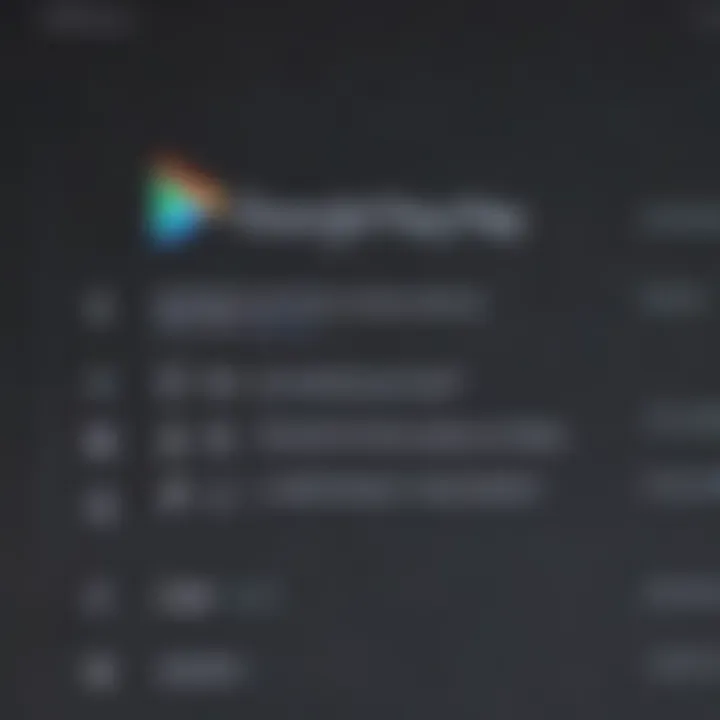Understanding Google Play Services in Detail


Intro
In today’s technology-driven world, understanding the role of software platforms is essential. Google Play Services is a critical component of the Android operating system. It acts as a bridge between Google’s online services and Android apps, providing essential functionality and enhancing user experience.
Without Google Play Services, many functionalities of Android devices could be compromised. Users rely heavily on it for everything from authenticating accounts to accessing location services. This article aims to demystify this software. Whether you are just beginning your journey with Android, or you are an experienced user, comprehending Google Play Services can profoundly affect how you interact with your device.
We will explore its significance, check how to install and troubleshoot, and analyze its impact on performance. For avid smartphone users and tech enthusiasts, these insights can help maximize the use of Android devices.
Overview of Google Play Services
What is Google Play Services?
Google Play Services is a background service that enables applications on Android devices to communicate with Google APIs and services. It is not an application that you can see on your home screen. Instead, it works behind the scenes, ensuring smooth performance of apps and enabling a suite of features.
Importance of Google Play Services
The significance of Google Play Services cannot be understated. Here are some key functions:
- Authentication: Helps users gain access to apps using their Google accounts without repetitive logins.
- Location Services: Allows apps to tap into coarse and fine location data, enhancing navigation and location-based services.
- Cloud Messaging: Ensures real-time notifications between applications, keeping users updated.
Installation Process
Installing Google Play Services is often straightforward. Here's a step-by-step guide:
- Open Settings: On your Android device, locate the Settings app.
- Navigate to Apps: Find the Apps section to see a list of all installed applications.
- Google Play Services: Scroll to find Google Play Services. If it’s not installed, you may need to download it from the Google Play Store or directly from a trusted source.
Ensuring Compatibility
Before installation, ensure your device is compatible with the version of Google Play Services you are downloading. This minimizes potential issues during use.
Troubleshooting Common Issues
Despite its importance, users often encounter problems with Google Play Services. Common issues include app crashes, slow performance, or missing notifications. Here are some solutions:
- Clearing Cache: Go to Settings > Apps > Google Play Services, then clear the cache.
- Updating: Ensure you have the latest version installed. Check the Google Play Store for updates.
- Reboot: Simple but effective; often, a quick reboot can resolve many minor issues.
"Understanding the underlying services in Android, like Google Play Services, enhances not only user experience but also improves device performance."
Impact on App Performance
Google Play Services significantly influences the performance of apps on Android devices. Apps that rely on these services can function smoothly, providing features such as:
- Seamless updates including new features
- Enhanced security through authentication
- Access to large datasets for personalized experiences
Intro to Google Play Services
Understanding Google Play Services is essential for anyone interacting with Android devices. Google Play Services acts as a bridge between apps and the core functionalities of the Android operating system. In this section, we will explore its definition, role, and significance in enhancing device performance and user experience.
Definition and Role
Google Play Services is not an application seen directly by users, yet it is integral to the functionality of many apps on Android. It is a backend service that facilitates operations like authentication, location tracking, and cloud storage. It updates automatically and supports app developers by providing tools and APIs for building high-performing applications.
The role of Google Play Services is multifaceted. It enables developers to integrate features such as Google Sign-In, Google Maps, and push notifications seamlessly. When users install applications requiring these features, Google Play Services manages the interaction, ensuring smooth performance.
Importance for Android Devices


Google Play Services is crucial for the Android ecosystem. Its importance can be deduced from several points:
- Seamless User Experience: By managing services like location, payment, and cloud storage, it allows apps to function efficiently without errors. Users experience less downtime and smoother app interactions.
- Security Updates: Google Play Services plays a significant role in maintaining app security. Regular updates address vulnerabilities that can be exploited by malware or cyber-attacks. This helps keep user data safe and enhances overall device security.
- Cross-App Functionality: With shared services, different applications can work together more efficiently. For instance, location data can be shared across multiple apps, allowing for improved functionality in navigation and travel.
In summary, Google Play Services is foundational to the Android operating environment. Its various roles and the importance it holds in the ecosystem make it a pivotal aspect for users and developers alike.
Core Components of Google Play Services
Google Play Services is the backbone of the Android ecosystem, linking various functionalities and applications seamlessly. Understanding its core components is vital for users who want to maximize their device's capabilities. The following elements not only enhance user experience but also facilitate interaction between different apps. The benefits of these components span wide areas, allowing users to engage directly with their devices' potential offerings.
Location Services
Location services in Google Play Services allow applications to access location data. This component utilizes various signals, such as GPS, cell towers, and Wi-Fi to deliver precise location information. The importance of accurate location tracking cannot be underestimated, particularly for apps requiring real-time navigation or location-based services.
Benefits include improved user experiences in applications like ride-sharing services, mapping apps, and local event aggregators. However, there are considerations regarding battery consumption and privacy concerns. Users might want granular control over which apps can access their location. This feature's effectiveness relies on the balance of convenience and respective drawbacks.
Google Sign-In
Google Sign-In simplifies the authentication process for users. This component allows users to sign into apps with their Google accounts, fostering a smooth transition between services. The ease of linking accounts increases user retention and satisfaction.
This integration reduces the need for multiple usernames and passwords, which can lead to improved security if managed correctly. However, users should be mindful of their data sharing preferences. Understanding how their information is being used in this ecosystem is essential for maintaining individuality in a connected world.
Google Maps Integration
Google Maps is perhaps one of the most well-utilized aspects of Google Play Services. It combines location data and mapping functionalities, delivering high-quality navigation features directly embedded within applications. Businesses and developers can plug into this resource, enhancing user engagement through location targeting.
The vast database of locations and points of interest allows users to discover new places effectively. Moreover, it provides real-time traffic updates, enriching the navigation experience. Yet, while the component offers significant advantages, concerns about dependency on a single mapping service can arise. Thus, diversification and awareness of other available mapping tools may enhance decision-making.
Cloud Messaging
Cloud Messaging, specifically Firebase Cloud Messaging, offers a robust method for sending messages and notifications to Android devices. This component is crucial for user engagement, whether it involves alerting users to new content, updates, or promotional offers.
Notifications through cloud messaging can be tailored to user preferences, enhancing relevance and interaction. However, overusing this feature may lead to user fatigue, where too many alerts could annoy rather than inform. Developers should use this tool wisely to maintain user trust and interest.
In sum, each of these core components plays a pivotal role in the practical functionality of Google Play Services. With a clear understanding, users can navigate these services better, making informed choices on app usage and permissions.
Installation of Google Play Services
Understanding how to install Google Play Services is essential for ensuring that Android devices operate at their best. Google Play Services is a vital component that facilitates various functions in apps, such as location services, authentication, and notifications. Without proper installation, users may encounter a range of issues, including app malfunctions and limited access to features.
Knowing how to install and update Google Play Services empowers users. It provides them the knowledge to maintain their devices in optimal shape, thereby enhancing performance and user experience. With this section, we will explore the steps to check existing installations, update the services if necessary, and perform a manual installation when needed.
Checking Existing Installation
To check if Google Play Services is already installed on your Android device, follow these steps:
- Open the Settings app on your device.
- Scroll down and select Apps or Application Manager.
- Look for Google Play Services in the list of installed applications.
If it appears here, it confirms that the service is already installed. Knowing the version can be crucial. Users can tap on it to view additional information, including how much storage it occupies and its current permissions.
Checking existing installations helps users avoid unnecessary updates and potential conflicts with apps that depend on the services.
Updating Google Play Services
Frequent updates to Google Play Services help in fixing bugs, enhancing performance, and expanding compatibility with newer applications. To ensure the app is updated:


- Visit the Google Play Store.
- Search for Google Play Services.
- If an update is available, an Update button will show up.
- Tap Update to begin the process.
Keeping Google Play Services updated is recommended to ensure that all related applications function appropriately. This can minimize crashes and improve security.
Manual Installation Guide
Manual installation of Google Play Services may become necessary if users face problems with updates or if they have rooted devices that do not allow automatic updates. This guide will cover the requirements for manual installation and the necessary steps to download the APK file.
Requirements for Manual Installation
Before proceeding with a manual installation, users should verify a few essential requirements:
- Device Compatibility: Ensure your device is compatible with the version of Google Play Services you plan to install.
- Internet Connection: A stable connection is critical for downloading the APK file.
- Unknown Sources Enabled: Users must allow installations from unknown sources in the device settings.
Having these requirements in check will facilitate a smooth installation process. Moreover, it allows users to install custom or older versions of Google Play Services that might offer better compatibility with specific apps.
Steps for Downloading the APK
To manually download the APK for Google Play Services, follow these steps:
- Go to a reliable APK site such as APKMirror.
- Search for Google Play Services in the search bar.
- Select the appropriate version based on your device's requirements.
- Tap on the Download button.
- Once the download finishes, go to the Downloads folder to find the APK file.
- Tap on the APK file and follow the prompts to install.
These steps make the manual installation process clear and manageable. By downloading the APK file, users can bypass issues faced in the traditional update route and have more control over what version they have on their device.
Troubleshooting Google Play Services
Troubleshooting Google Play Services is vital due to its significance in the overall functionality of Android devices. Typically, users encounter various issues that affect their experience, causing frustration when trying to access apps and services. Therefore, identifying and resolving these problems becomes essential in maintaining device efficiency. Better troubleshooting leads to enhanced user satisfaction and improved performance.
Common Issues Encountered
Understanding common issues provides insight into why problems arise. It is a good foundation for effective troubleshooting and to inform users where their devices might fail.
Unable to Connect to Google Play Services
This issue is prevalent among users. When one is unable to connect to Google Play Services, applications may not operate as intended. This impacts the overall Android experience, especially if an app relies on Google services for functionality. One key characteristic is that this issue often arises from network problems or misconfigurations. A beneficial aspect is that users can fix it with a few adjustments. Unique features include the ability to reset network settings, which can often clear up the problem. However, being repeatedly unable to connect might indicate deeper issues that require attention.
App Crashes Related to Google Play Services
Crashing apps are a significant aspect related to Google Play Services. When apps crash due to this service, it disrupts tasks and leads to inconvenience. The user may notice that various apps behave erratically or simply shut down unexpectedly. This issue is common and can often stem from outdated versions of Google Play Services or other app dependencies. The unique aspect of this problem lies in its unpredictability; it can happen without warning. The advantages of addressing such issues early can prevent loss of important data and improve device reliability in the long term.
Step-by-Step Troubleshooting
Once a user identifies a problem, they can apply systematic approaches to troubleshooting. This process is essential for clarity and efficiency in resolving issues.
Clearing Cache and Data
Clearing cache and data is a fundamental troubleshooting step. It can resolve various issues with Google Play Services and related apps. The key characteristic of this process is its ability to free up memory and remove potentially corrupted data. It is popular because it is simple and effective for most issues. The unique feature of this step is that it does not remove personal data; instead, it resets the app state. Advantages include quicker app response times and improved stability after clearing.
Reinstalling Google Play Services
Reinstalling Google Play Services serves as a more drastic approach to fixing persistent problems. This method restores the service to its original state and can solve issues that simple fixes cannot. The key characteristic here is its potential for comprehensive resolution, as reinstalling replaces any corrupted files. It is beneficial for seriously troubled devices. However, this process requires some caution; users must ensure they follow correct installation procedures to avoid further complications. The result can often lead to a significant improvement in app performance after resolving long-standing issues.
Impact of Google Play Services on Applications
The influence of Google Play Services on applications is profound. These services are the backbone of numerous functionalities that users expect from modern apps on their Android devices. Effectively, they bridge the gap between applications and the integrated features of the operating system. Understanding this impact helps developers and users alike to appreciate the critical role of these services.


Enhancing User Experience
Google Play Services significantly uplifts the user experience by providing a seamless integration of various features. One of the most notable aspects is how it enables user authentication. With Google Sign-In, users can quickly log into apps without needing to remember new passwords or fill long forms. This feature not only saves time but also reduces friction, which is crucial for maintaining engagement.
Moreover, Google Play Services supports location-based services. Through the integration of Location Services, apps can offer real-time navigation, personalized recommendations, and geo-fencing features, which enhances the user's interaction with the surroundings. This capability is particularly beneficial for applications in sectors like travel, food delivery, and real estate.
Another element is the straightforward access to Google Maps. When apps utilize Google Maps Integration, they provide accurate mapping services and information about nearby places. This feature is immensely helpful for users looking to explore locations or navigate unfamiliar areas effectively.
Additionally, the consistent and timely updates from Google Play Services ensure that apps remain compatible with the latest security protocols and features. As a result, users can trust the apps they use, knowing that they are safeguarded against vulnerabilities. Overall, the enhancements provided by Google Play Services relay a rich, user-friendly experience that keeps users coming back.
Managing Background Processes
Background processes are crucial for app functionality, especially for features that need to run without user interaction. Google Play Services is instrumental in managing these processes efficiently. This is particularly relevant when it comes to tasks like push notifications or fetching data in the background.
With Cloud Messaging, apps can send notifications to users, keeping them engaged and informed in real time. For example, messaging apps like WhatsApp leverage this feature to alert users of new messages even when the app is not actively in use. This ability ensures users do not miss important updates.
Moreover, Google Play Services help manage battery usage effectively while performing background operations. Developers can design their applications to handle background tasks intelligently, reducing power consumption and prolonging battery life. This aspect is increasingly vital in situations where users depend on their devices throughout the day without having to recharge.
In summary, Google Play Services not only enhance the user experience through integrated features but also optimize app performance by managing background processes adeptly. Such capabilities underscore their importance in the Android ecosystem, making applications more functional and enjoyable for end-users.
"Google Play Services is essential for any app aiming to provide a modern user experience and efficient background operation."
Integrating these services means accessing a toolkit of features that make applications robust and capable. Thus, understanding this impact is indispensable for both developers and users in the evolving landscape of mobile technology.
Alternatives to Google Play Services
The discussion around alternatives to Google Play Services is increasingly relevant in today’s tech landscape. Many users seek options due to privacy concerns, system performance issues, or simply a desire for increased flexibility. The significance of exploring alternatives lies not only in the hope of finding better solutions but also in understanding the limitations and implications that come along with these decisions. By delving into open-source alternatives and the broader implications of using them, users can make informed choices tailored to their needs.
Open Source Alternatives
When looking for alternatives to Google Play Services, open source options stand out due to their transparency and flexibility. Open source software encourages community collaboration, which often leads to a more rapid evolution and improvement of the applications. Some notable open-source alternatives include F-Droid, MicroG, and LineageOS.
- F-Droid - This is a software repository that offers a collection of open-source applications for Android. It provides users with the ability to download apps without the influence of Google’s restrictions.
- MicroG - A lightweight implementation of Google Play Services, MicroG allows users to enjoy applications that require Google APIs, yet without the need for full Google Services. Its lightweight nature is beneficial for devices with limited resources.
- LineageOS - This is an alternative operating system for Android devices that eliminates unnecessary bloatware and provides a more customizable user experience. Users can integrate MicroG into LineageOS for enhanced functionality.
These alternatives not only ensure that users can access applications effectively but also permit personal control over their devices without compromising on essential functions.
Implications of Using Alternatives
Utilizing alternatives to Google Play Services can be beneficial but comes with its share of cautions. Below are some implications users should consider:
- Compatibility Issues: Not all applications will work seamlessly without Google Play Services. Users may encounter difficulty with apps that heavily rely on these services. Some essential features might be limited or unavailable altogether.
- Security Risks: While open-source projects often prioritize security, users need to be vigilant about the sources from which they download applications. Unofficial sources may expose users to malware or other security risks.
- User Experience Variability: While open source applications can offer unique functionalities, the overall user experience may differ from that of mainstream applications often optimized for Google’s ecosystem.
In light of these considerations, users should weigh the pros and cons carefully. Making a transition to alternatives requires a keen understanding of one’s specific needs, which is pivotal in achieving a more tailored Android experience.
Epilogue
In wrapping up this comprehensive guide, it is vital to reflect on Understanding Google Play Services and its significance within the Android ecosystem. This article covered various aspects, including its core components, the installation process, common troubleshooting techniques, its impact on application performance, and alternatives available in the market.
Recap of Key Points
Google Play Services is not just a background system; it is foundational for the functionality of Android devices. Here are the key points that demand attention:
- Role in User Experience: Google Play Services enhances user engagement by providing features that improve the overall functionality of apps.
- Dependency for Apps: Many applications rely heavily on Google Play Services for critical features such as location tracking, messaging, and user authentication through Google Sign-In.
- Installation and Maintenance: Proper installation, updates, and troubleshooting methods ensure that the services run smoothly, minimizing disruptions that may hinder user experience.
- Alternatives Considerations: Exploring open-source options can provide flexibility, but users must weigh the implications on performance and compatibility.
Final Thoughts
As we conclude this guide, it is clear that Google Play Services is a pivotal component of the Android platform. Its broad functionality not only supports countless applications but also underpins the entire ecosystem. Users and developers alike must remain informed about its role to maximize performance and resolve issues efficiently. The knowledge shared in this article aims to empower readers to navigate the Android landscape more effectively.
"Understanding the intricacies of Google Play Services will enhance not just user satisfaction, but also the development potential for apps in a competitive marketplace."
In essence, a deeper comprehension of Google Play Services enriches the relationship between users, developers, and devices in today's tech-driven environment.



